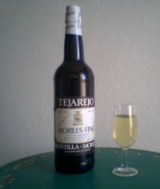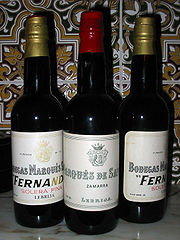
Fino
Encyclopedia
Fino is the driest and palest of the traditional varieties of sherry
. They are drunk comparatively young, and unlike the sweeter varieties should be drunk soon after the bottle is opened as exposure to air can cause them to lose their flavour within hours.
known as flor
that floats in a layer on top of sherry in the wine barrel
. Until the mid-19th century most sherry winemakers did not understand what this yellowish foam that randomly appeared in some of their barrels was. They would mark these barrels as "sick" and relegate them to their lowest bottlings of wine. It turned out that this strain of Saccharomyces
yeast thrived in air, and the more "head room" there was in the barrel the more likely it was to develop. Over time winemakers noticed that these wines were lighter and fresher than their other sherries, with the flor acting as a protective blanket over the wine that shielded it from excessive oxidation.

. The juice that comes after pressing is typically more coarse and produces heavier bodied wines. That juice is typically used to make oloroso
sherry.
When first barreled, sherries made using the fino method are only partially filled to allow the action of the flor
yeast to give it the distinctive fresh taste of dry sherries. If the flor is allowed to die and the wine undergoes oxidative aging, the wine darkens and the flavour becomes stronger, resulting in an amontillado
sherry.
In the final classification of a fino, it is judged on such qualities as cleanness, paleness, dryness, and aroma. According to the overseer's judgment, the initial stroke mark on the cask may then be embellished with one or more 'palm leaves'--curved marks that branch off the side of the initial mark. Wines receiving these marks are designated accordingly 'una palma,' 'dos palmas,' 'tres palmas,' with each additional palm leaf indicating a higher standard of quality.
Since sherry is not vintage dated, it can be hard to tell when the Fino was bottled. However, the bottling date is printed on the label, albeit in an encoded form. On the back label will be a small dot matrix number that starts with the letter L. After the L will be either a 4 or 5 digit number. For the 4 digit number, such as 7005, the first number is the year, and the last three numbers are a number between 1 and 365 that indicates the day of the year. So this bottle was bottled on 5 January 2007. The 5 digit code is similar, such as 00507, where the Julian date precedes the year. This was also 5 January 2007.
of some form, such as olives, almonds, or seafood.
Sherry
Sherry is a fortified wine made from white grapes that are grown near the town of Jerez , Spain. In Spanish, it is called vino de Jerez....
. They are drunk comparatively young, and unlike the sweeter varieties should be drunk soon after the bottle is opened as exposure to air can cause them to lose their flavour within hours.
Flor
The defining component of Fino sherries is the strain of yeastYeast
Yeasts are eukaryotic micro-organisms classified in the kingdom Fungi, with 1,500 species currently described estimated to be only 1% of all fungal species. Most reproduce asexually by mitosis, and many do so by an asymmetric division process called budding...
known as flor
Flor
Flor is a winemaking term referring to a film of yeast on the surface of wine and which is important in the manufacture of certain styles of sherry. The flor is formed naturally under certain winemaking conditions, from indigenous yeasts found in the region of Andalucía in southern Spain...
that floats in a layer on top of sherry in the wine barrel
Wine barrel
The use of oak plays a significant role in winemaking and can have a profound effect on the resulting wine, affecting the color, flavor, tannin profile and texture of the wine. Oak can come into contact with wine in the form of a barrel during the fermentation or aging periods...
. Until the mid-19th century most sherry winemakers did not understand what this yellowish foam that randomly appeared in some of their barrels was. They would mark these barrels as "sick" and relegate them to their lowest bottlings of wine. It turned out that this strain of Saccharomyces
Saccharomyces
Saccharomyces is a genus in the kingdom of fungi that includes many species of yeast. Saccharomyces is from Greek σάκχαρ and μύκης and means sugar fungus. Many members of this genus are considered very important in food production. One example is Saccharomyces cerevisiae, which is used in making...
yeast thrived in air, and the more "head room" there was in the barrel the more likely it was to develop. Over time winemakers noticed that these wines were lighter and fresher than their other sherries, with the flor acting as a protective blanket over the wine that shielded it from excessive oxidation.
Varieties

- Jerez Fino, made from grapes grown in the vineyards around Jerez and aged in the bodegaBodegaBodega is a Spanish word that may refer to:* a winery, wine cellar or wine bar* a convenience store specializing in Hispanic groceriesPlaces:* Bodega, California, town in Sonoma County, California...
s there, where the climate is hotter than those near the coast. The hotter summers cause Jerez fino to develop a thinner layer of flor and thus a stronger flavour due to more exposure to the air. - Puerto Fino, made around El Puerto de Santa MaríaEl Puerto de Santa MaríaEl Puerto de Santa María is a municipality located on the banks of the Guadalete River in the province of Cádiz, Spain. , the city has a population of c...
. The cooler climate near the sea results in a thicker layer of flor and a more acidic and delicate flavour than Jerez fino. - Manzanilla, made around Sanlúcar de BarramedaSanlúcar de BarramedaSanlúcar de Barrameda is a city in the northwest of Cádiz province, part of the autonomous community of Andalucía in southern Spain. Sanlúcar is located on the left bank at the mouth of the Guadalquivir River opposite the Doñana National Park, 52 km from the provincial capital Cádiz and...
, where the climate is cooler than El Puerto de Santa María. Similar to the Puerto Fino, manzanilla has a fresher and more delicate flavour than Jerez fino. - Pale Cream Sherry is a sweetened Fino.
Production
In production of finos, winemakers normally will only use the free run juice-the juice that is produced by crushing the grapes under their own weight before they are sent to a wine pressWine press
A wine press is a device used to extract juice from crushed grapes during wine making. There are a number of different styles of presses that are used by wine makers but their overall functionality is the same. Each style of press exerts controlled pressure in order to free the juice from the fruit...
. The juice that comes after pressing is typically more coarse and produces heavier bodied wines. That juice is typically used to make oloroso
Oloroso
Oloroso is a variety of sherry produced by oxidative aging. It is normally darker than amontillado and has a higher glycerine content, which makes it smoother and less dry. Oloroso is usually dark and nutty....
sherry.
When first barreled, sherries made using the fino method are only partially filled to allow the action of the flor
Flor
Flor is a winemaking term referring to a film of yeast on the surface of wine and which is important in the manufacture of certain styles of sherry. The flor is formed naturally under certain winemaking conditions, from indigenous yeasts found in the region of Andalucía in southern Spain...
yeast to give it the distinctive fresh taste of dry sherries. If the flor is allowed to die and the wine undergoes oxidative aging, the wine darkens and the flavour becomes stronger, resulting in an amontillado
Amontillado
Amontillado is a variety of sherry, characterized by being darker than fino but lighter than oloroso. It is named for the Montilla region of Spain, where the style originated in the 18th century, although the name 'amontillado' is sometimes used commercially as a simple measure of colour to label...
sherry.
In the final classification of a fino, it is judged on such qualities as cleanness, paleness, dryness, and aroma. According to the overseer's judgment, the initial stroke mark on the cask may then be embellished with one or more 'palm leaves'--curved marks that branch off the side of the initial mark. Wines receiving these marks are designated accordingly 'una palma,' 'dos palmas,' 'tres palmas,' with each additional palm leaf indicating a higher standard of quality.
Storing
Fino is the most delicate form of sherry and should be drunk within a year of bottling, although some argue that fino should not be older than six months. Once opened it will immediately begin to deteriorate and should be drunk in one sitting for the best results. If necessary it can be stored, corked and refrigerated, for up to one week after opening.Since sherry is not vintage dated, it can be hard to tell when the Fino was bottled. However, the bottling date is printed on the label, albeit in an encoded form. On the back label will be a small dot matrix number that starts with the letter L. After the L will be either a 4 or 5 digit number. For the 4 digit number, such as 7005, the first number is the year, and the last three numbers are a number between 1 and 365 that indicates the day of the year. So this bottle was bottled on 5 January 2007. The 5 digit code is similar, such as 00507, where the Julian date precedes the year. This was also 5 January 2007.
Serving
As with particularly dry sherries, it is best served chilled at 7-10°C before a meal, and in Spain is almost always drunk with tapasTapas
Tapas are a wide variety of appetizers, or snacks, in Spanish cuisine. They may be cold or warm ....
of some form, such as olives, almonds, or seafood.

